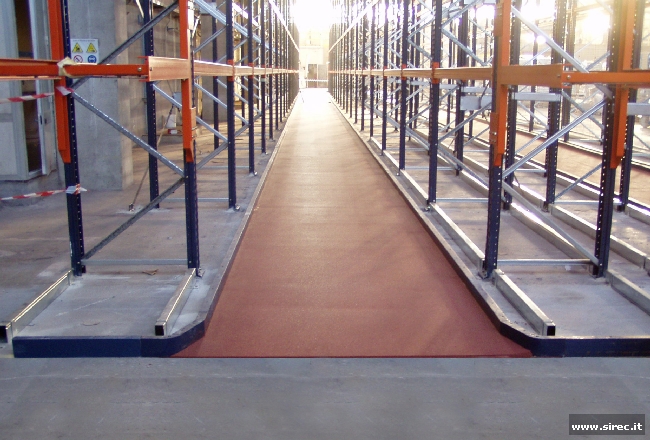FLOORS FOR LOGISTICS
A good floor is an important requirement to ensure safe movement and correct use of narrow aisle forklifts.
The flooring must be able to withstand loads, and be uniform and flat. Keeping to the tolerance values required by the manufacturers of the forklifts is of great importance for the functioning of the forklifts in terms of the allowed running speed, the simultaneous travel and lifting, the slow operation and precise positioning of the loads. The flatness tolerances must comply with the requirements of the forklift manufacturers applying the DIN 15185 -18202 standards. Because of insufficient uniformity and flatness of the floor, most narrow aisle forklifts are not able to exploit fully their potential for handling performance.
With the industrial concrete floor, given its nature (subject to uncontrolled contractions) and the laying and processing system, it is very difficult to obtain the flatness tolerances compliant with DIN 18202-15185; therefore, before installing an intensive narrow aisle warehouse system, it is advisable to check the degree of flatness of the floor with the use of a high-precision optical level.
After the survey, a document (preferably in graphic form) certifying the flatness status must be drafted. If the flatness requirements comply with DIN 15185, the uniformity must also be checked on short routes, with a metal rule, in order to avoid the "ripple effect" that can cause vibrations of the forklift - DIN 18202 -. If the flatness requirements do not meet the above standards, a correction must be performed by laying a variable thickness resin floor system in the individual lanes, using "EPOXIBETON", based on the elevation of the support.
N.B. - many times "self-levelling" resin systems are used for correcting the flatness. Such a system is not suitable for a "correction" since it is constant thickness flooring and its use, although it improves the undulations of the support in the short term, it does not change the flatness. Therefore, the "self-levelling" system may only be used if the floor meets the DIN 15185 standard but not the DIN 18202 (ripple effect).
In both cases the surface must meet the following requirements:
- resistance to oils and greases
- resistance to ground - RE - determined in compliance with EN 1081 (formerly DIN 51953) - not more than 106 Ohm
- braking distance complies with rule 15160 - part 1
- friction coefficient approx. μ 0.5

